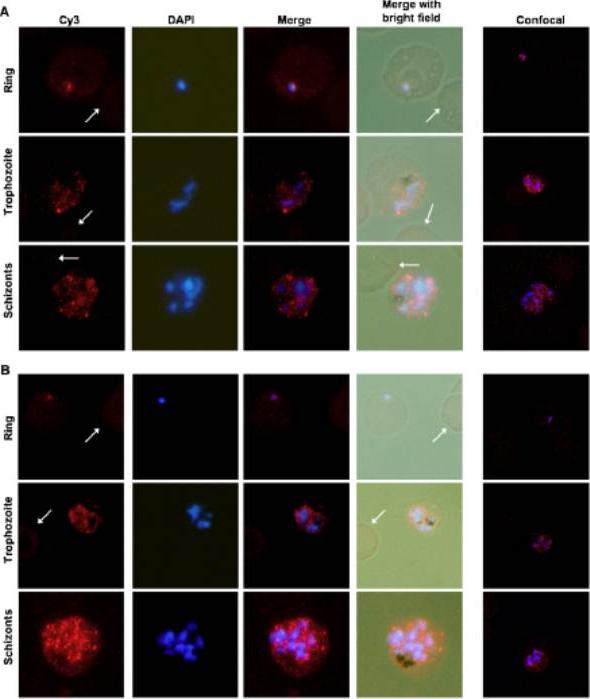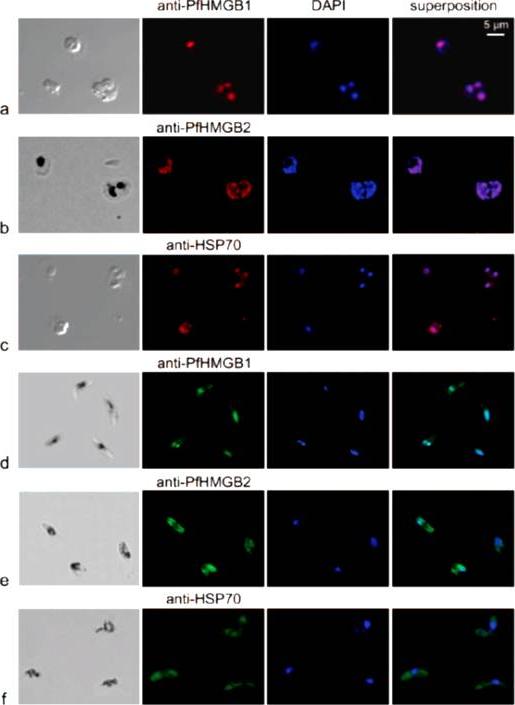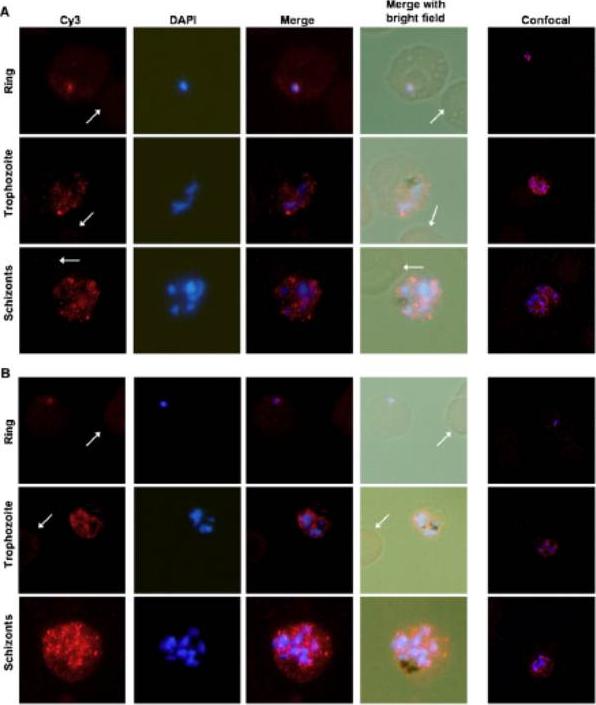PY17X_0604400 high mobility group protein B1, putative (HMGB1)
Disruptability [+]
No information reported yet. Please press the '+' button above to add some.Mutant phenotypes [+]
None reported yet. Please press the '+' button above to add one.Imaging data (from Malaria Metabolic Pathways)

Localization of PfHMGB1 and PfHMGB2 in 3D7 Plasmodium falciparum parasite. mmunofluorescence in ring, trophozoite and schizonts of P. falciparum with anti-HMGB1 [A] and anti-HMGB2 [B] using IFA and confocal microscopy were analyzed. In column I, staining with anti-HMGBs is shown, while in column II staining with DAPI, column III merge of staining with anti-HMGBs and DAPI, column IV, merge of staining by anti-HMGBs and DAPI with the bright field of the corresponding parasites is presented. Column V, confocal images are shown. Uninfected RBCs were represented with arrowhead, where no fluorescence signal was observed. Both gene products were present in the nucleus at the ring stage . However,significant amount of these proteins were also present inthe parasite cytosol at the trophozoite and schizont stagesKumar K, Singal A, Rizvi MM, Chauhan VS. High mobility group box (HMGB) proteins of Plasmodium falciparum: DNA binding proteins with pro-inflammatory activity. Parasitol Int. 2008 57(2):150-7.
See original on MMP
Immunofluorescence localization of PfHMGB1 and PfHMGB2 in asexual (a, b, and c) and sexual (d, e, and f) stages of Plasmodium erythrocytic development. Paraformaldehyde-fixed parasites were labeled with mouse anti-PfHMGB1 and anti-PfHMGB2 antibodies (1:200) and FITC-conjugated anti-mouse IgG (1:100); DNA was stained with DAPI (1:100). Merged fluorescent signals are shown in the “superposition” column. Cells were visualized by phase-contrast (a and c) or transmission (b, d, e, and f) microscopy. Panels: a, trophozoites; b, trophozoite and schizont; c, trophozoites; d to f, gametocytes. Anti-PfHMGB and anti-HSP70 fluorescence is red for panels a to c and green for panels d to f. We also compared the localizations of both factors in asexual (red immunofluorescence) and gametocyte (green immunofluorescence) stages. As already mentioned, the two PfHMGB factors (lanes a and b) appeared to be located mainly in the nucleus of the asexual stages (rings, trophozoites, and schizonts), whereas the HSP70 protein (lane c) was also found in the parasite cytoplasm. Surprisingly, in addition to its nuclear localization, PfHMGB2 could also be readily detected within the cytoplasm of different stages (IV and V) of gametocytes (lanes e), as also observed for the HSP70 protein (lane f), whereas PfHMGB1 was associated mainly with the nucleus of gametocytes, as in asexual parasites (lanes d and a).Briquet S, Boschet C, Gissot M, Tissandié E, Sevilla E, Franetich JF, Thiery I, Hamid Z, Bourgouin C, Vaquero C. High-mobility-group box nuclear factors of Plasmodium falciparum. Eukaryot Cell. 2006 5(4):672-82.
See original on MMP
Localization of PfHMGB1 and PfHMGB2 in 3D7 Plasmodium falciparum parasite. mmunofluorescence in ring, trophozoite and schizonts of P. falciparum with anti-HMGB1 [A] and anti-HMGB2 [B] using IFA and confocal microscopy were analyzed. In column I, staining with anti-HMGBs is shown, while in column II staining with DAPI, column III merge of staining with anti-HMGBs and DAPI, column IV, merge of staining by anti-HMGBs and DAPI with the bright field of the corresponding parasites is presented. Column V, confocal images are shown. Uninfected RBCs were represented with arrowhead, where no fluorescence signal was observed. Both gene products were present in the nucleus at the ring stage . However,significant amount of these proteins were also present inthe parasite cytosol at the trophozoite and schizont stagesKumar K, Singal A, Rizvi MM, Chauhan VS. High mobility group box (HMGB) proteins of Plasmodium falciparum: DNA binding proteins with pro-inflammatory activity. Parasitol Int. 2008 57(2):150-7.
See original on MMPMore information
| PlasmoDB | PY17X_0604400 |
| GeneDB | PY17X_0604400 |
| Malaria Metabolic Pathways | Localisation images Pathways mapped to |
| Previous ID(s) | null |
| Orthologs | PBANKA_0601900 , PCHAS_0603700 , PF3D7_1202900 , PKNH_1302800 , PVP01_1302200 , PVX_084190 |
| Google Scholar | Search for all mentions of this gene |